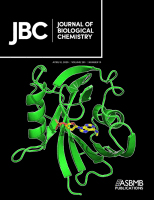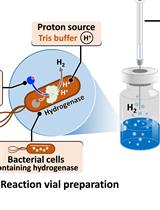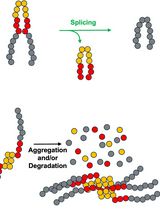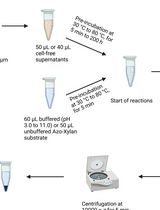- EN - English
- CN - 中文
In vitro Nitrate Reductase Activity Assay of Mycolicibacterium smegmatis Crude Extract
耻垢分枝杆菌粗提物硝酸还原酶活性的体外测定
发布: 2021年07月20日第11卷第14期 DOI: 10.21769/BioProtoc.4098 浏览次数: 3223
评审: Partha Basu Valentine V Trotter
Abstract
Nitrate is one of the major inorganic nitrogen sources for microorganisms. Many bacterial and archaeal lineages can express cytoplasmic assimilatory nitrate reductase (NAS), which catalyzes the rate-limiting reduction of nitrate to nitrite in the nitrate assimilation pathway. Here, we present a detailed protocol for measuring in vitro nitrate reductase (NaR) activity of NAS enzymes from Mycolicibacterium smegmatis crude extract using both physiological and non-physiological electron donors.
Keywords: Mycolicibacterium smegmatis (耻垢分枝杆菌)Background
In addition to being an important nitrogen source for plants, nitrate (NO3-) is universally used as an inorganic nitrogen source for microorganisms, particularly soil bacteria such as actinomycetes, as well as marine bacteria such as cyanobacteria, due to fierce competition for limited nutrients in the natural environment (Kuypers et al., 2018). In prokaryotes, nitrate is reduced to ammonia (NH3) through two sequential steps, with the first committed step catalyzed by NAS. Prokaryotic NASs are categorized based on the physiological electron donors utilized (Morozkina and Zvyagilskaya, 2007; Tan et al., 2020), i.e., the flavodoxin- or ferredoxin-dependent NAS and the NAD(P)H-dependent NAS; however, to date, there have been few reports detecting in vitro NaR activity of bacterial NAD(P)H-dependent NASs employing their physiological electron donors. Instead, methyl viologen (an artificial chemical reductant) is the most commonly used electron donor for in vitro NaR activity assays.
In this protocol, employing an optimized assay system, NAD(P)H-dependent NaR activity can be measured in M. smegmatis crude cell extract. Briefly, the enzyme samples prepared under anaerobic conditions can use both NADPH and NADH as electron donors for catalysis in vitro. Nitrite produced by nitrate reduction forms a colored azo compound with sulfanilamide and N-(1-naphthyl)ethylenediamine dihydrochloride, which can be measured by its absorbance at 540 nm. This method is suitable for the determination of in vitro NaR activity of bacterial NAS enzymes.
Materials and Reagents
Mycolicibacterium smegmatis mc2155
Middlebrook 7H10 agar (BD Biosciences, catalog number: 262710)
Middlebrook 7H9 broth (BD Biosciences, catalog number: 271310)
Glycerol (Sigma-Aldrich, catalog number: G5516)
Tween 80 (Sigma-Aldrich, catalog number: P1754)
Ethanol (Sigma-Aldrich, catalog number: 51976)
Phenylmethanesulfonyl fluoride (PMSF) (Sigma-Aldrich, catalog number: P7626)
Bradford protein assay kit (Beyotime, catalog number: P0006)
Sodium nitrate (NaNO3) (Sigma-Aldrich, catalog number: S5506)
Sodium nitrite (NaNO2) (Sigma-Aldrich, catalog number: S2252)
Sodium phosphate dibasic (Na2HPO4) (Sigma-Aldrich, catalog number: 255793)
Sodium phosphate monobasic (NaH2PO4) (Sigma-Aldrich, catalog number: S3139)
Nicotinamide adenine dinucleotide phosphate (NADPH) (Sigma-Aldrich, catalog number: N7505)
Nicotinamide adenine dinucleotide (NADH) (Sigma-Aldrich, catalog number: 43420)
Methyl viologen (Sigma-Aldrich, catalog number: 856177)
Flavin mononucleotide (FMN) (Sigma-Aldrich, catalog number: F2253)
Flavin adenine dinucleotide (FAD) (Sigma-Aldrich, catalog number: F6625)
Sodium hydrosulfite (Na2S2O4) (Sigma-Aldrich, catalog number: 71699)
Sodium bicarbonate (NaHCO3) (Sigma-Aldrich, catalog number: S6014)
Sulfanilamide (Sigma-Aldrich, catalog number: S9251)
N-(1-naphthyl)ethylenediamine dihydrochloride (NED) (Sigma-Aldrich, catalog number: 222488)
7H10 agar (see Recipes)
7H9 medium (see Recipes)
MPLN medium (see Recipes)
0.5 M sodium phosphate buffer, pH 7.5 (see Recipes)
0.1 M sodium phosphate buffer, pH 7.5 (see Recipes)
0.1 M PMSF (see Recipes)
60 mM Na2S2O4/NaHCO3 (see Recipes)
1% (w/v) sulfanilamide solution (see Recipes)
0.01% (w/v) NED solution (see Recipes)
Equipment
Pipette kit (Gilson, catalog number: F167300)
High-speed centrifuge (Beckman, catalog number: AVANTI JXN-26)
Ultrasonic cell disruptor (Beyotime, catalog number: E0385)
Ultrasonic bath equipped with a degas mode (Beyotime, catalog number: E0439)
250-ml and 2-L Erlenmeyer flasks
Petri dish (90 mm diameter)
37°C incubator
Incubator shaker
Water bath
Spectrophotometer
Anaerobic chamber (glove box) filled with mixed gas (nitrogen, 95%; hydrogen, 5%)
Note: Place the pipette kit, ultrasonic cell disruptor, and water bath inside the anaerobic chamber.
Software
Microsoft Excel
Procedure
文章信息
版权信息
© 2021 The Authors; exclusive licensee Bio-protocol LLC.
如何引用
Readers should cite both the Bio-protocol article and the original research article where this protocol was used:
- Tan, W., Shao, Z. and Zhao, G. (2021). In vitro Nitrate Reductase Activity Assay of Mycolicibacterium smegmatis Crude Extract. Bio-protocol 11(14): e4098. DOI: 10.21769/BioProtoc.4098.
- Tan, W., Liao, T. H., Wang, J., Ye, Y., Wei, Y. C., Zhou, H. K., Xiao, Y., Zhi, X. Y., Shao, Z. H., Lyu, L. D. and Zhao, G. P. (2020). A recently evolved diflavin-containing monomeric nitrate reductase is responsible for highly efficient bacterial nitrate assimilation. J Biol Chem 295(15): 5051-5066
分类
微生物学 > 微生物生物化学 > 蛋白质 > 活性
生物化学 > 蛋白质 > 活性
您对这篇实验方法有问题吗?
在此处发布您的问题,我们将邀请本文作者来回答。同时,我们会将您的问题发布到Bio-protocol Exchange,以便寻求社区成员的帮助。
Share
Bluesky
X
Copy link













